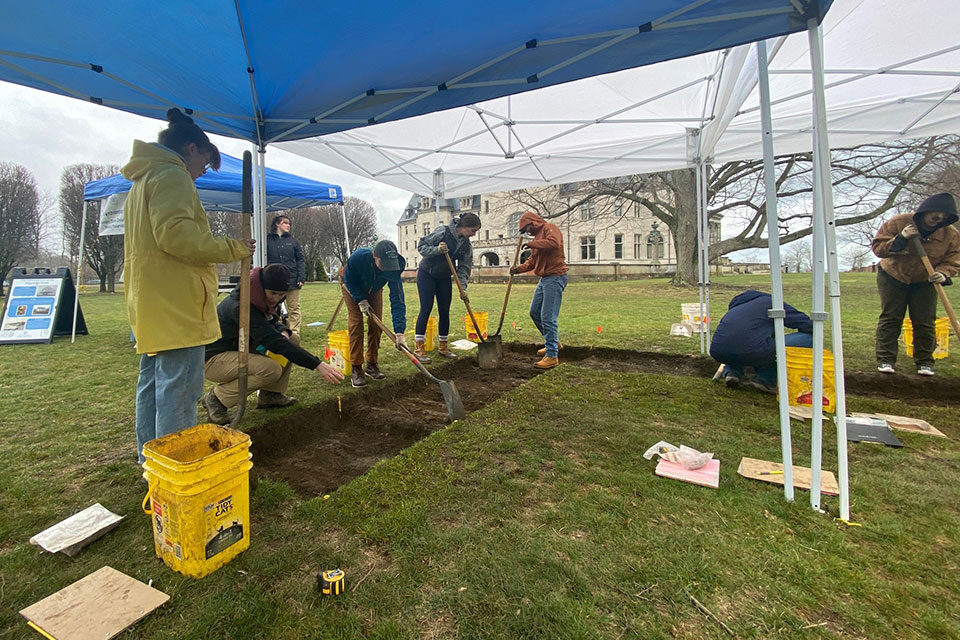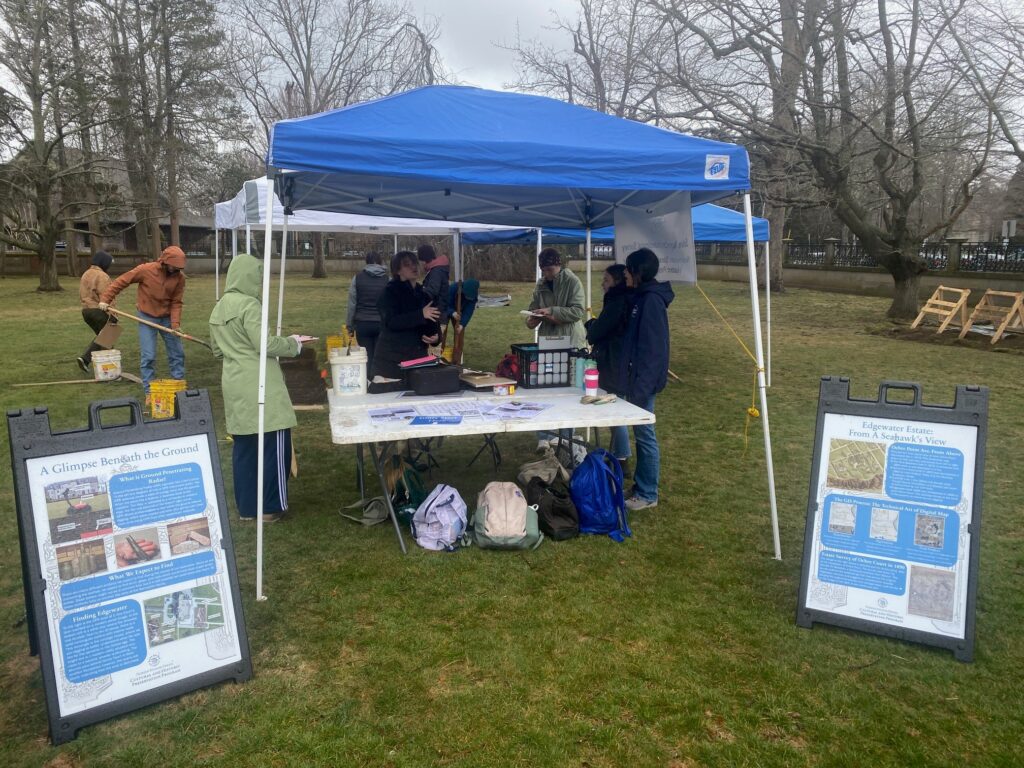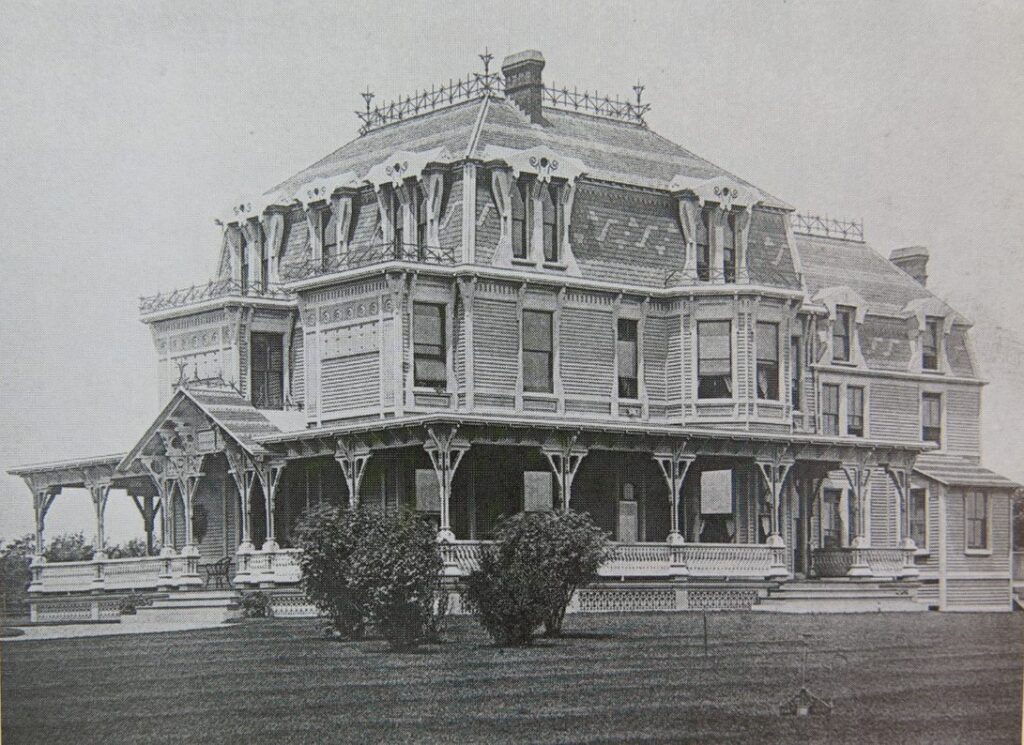Salve Regina students dig for evidence of short-lived mansion that pre-dated Ochre Court

Salve Regina students engaged in a semester-long project have begun putting shovels in the ground at Ochre Court, where they hope to excavate the buried remains of a carriage house that once serviced the short-lived Edgewater Mansion that stood on the plot 150 years ago.
The excavation site is open to the campus community and to the general public, who are invited to come take a tour or sign up as volunteers to dig alongside a student and learn how they conduct archeological investigations. More information on available dates for volunteers to join in the dig is available at Salve Regina’s 75th Anniversary Archaeological Survey webpage. No registration is required to attend tours.
“While our many historic buildings feel as though they have stood forever, this landscape has always been dynamic,” said Dr. Heather Rockwell, assistant professor in the Department of Cultural and Historic Preservation. “Where Ochre Court stands today, there was once the Edgewater Mansion, built in 1870 by the Kernochan family. Our excavations will provide hands-on experience for our students and may help us better understand what life was like at this spot one hundred and fifty years ago.”
The campus dig project, which coincides with the University’s year-long 75th anniversary celebration, is being run as part of a special topics course in the cultural and historic preservation program (CHP) and has 18 students enrolled from across many majors — including CHP, sociology and anthropology, history, studio art and marketing. The students spent the first half of the semester doing research and project preparation by writing a site background report utilizing deed traces, the Salve Regina archives and ancestry research.
“In small teams, they created interpretive panels which will be displayed at the project and detail the history of the property, the family who owned it, and how we identified this site,” Rockwell said.

Anyone is invited to take a tour of the dig site near Ochre Court, and people can also sign up for a spot to actually participate in the dig.
Each student also designed an interpretive site tour in the style of a National Parks Service Ranger, which they provide for visitors to the project.
James Powell Kernochan purchased the sub plot where Edgewater Mansion was built was from William Beach Lawrence, acting governor of Rhode Island during the 1850s, according to Rockwell. Kernochan commissioned George Champlin Mason to build Edgewater as a summer retreat and he then gave it to his brother, J. Frederic Kernochan, as a wedding present.
Completed in 1870, the Edgewater mansion was later sold to New York banker and real estate developer Ogden Goelet, who summered there for six years before demolishing the structure in 1888 to build his more opulent mansion, Ochre Court – where Salve Regina would eventually be founded in 1947.
“The property consisted of the mansion itself, positioned slightly closer to the water than Ochre Court, but they would have overlapping footprints,” said Rockwell. “Historic maps show a stable block and two small outbuildings that were located in the southwest portion of the front yard.”
Emma Valade ’23, a double major in CHP as well as sociology and anthropology, is working alongside Rockwell for an internship as the project’s field supervisor. She has been assisting with all of the managerial tasks associated with the project and will help Rockwell produce the final report that will be submitted to the State of Rhode Island.
“It’s very exciting to be able to do archaeological work on Salve’s campus and to contribute back the community,” Valade said. “This experience has also expanded my classroom education out into the real world and has develop the professional skills that I will need while pursuing a career in archaeology.”
Prior to starting their digging, Ground Penetrating Radar (GPR) studies helped students to identify where remnants of the stables and outbuildings still exist underground. The GPR work was completed as a workshop activity during the Cultural and Historic Preservation Conference hosted by Salve Regina during the fall.
Salve Regina students worked with Dr. Jesse Casana, professor of anthropology at Dartmouth College and a global expert in geophysical studies, along with Dr. David Leslie, principal investigator with Terrasearch Geophysical, to conduct the surveys of the property.
“An interesting facet of this is that it’s unclear how exactly the building was demolished,” Rockwell said. “Reports vary from just using the word ‘demolished’ or ‘razed,’ while others report the structure was ‘burned to the ground.’ It is our hope that excavations can help us shed a bit of light on how the building was demolished and what life was like in the late 19th century home.”
Students began their site work on March 21 and will be digging nearly every Tuesday and Thursday afternoon from 2:15-4:45 p.m. and most Saturdays from 9 a.m.-4 p.m. for the remainder of the spring 2023 semester. The excavation will be closed up during the final exam week of May 8-13, and it will be completely clear by May 11.
More information on available dates for volunteers to join in the dig is available at Salve Regina’s 7th Anniversary Archaeological Survey webpage. No registration is required to attend tours.


